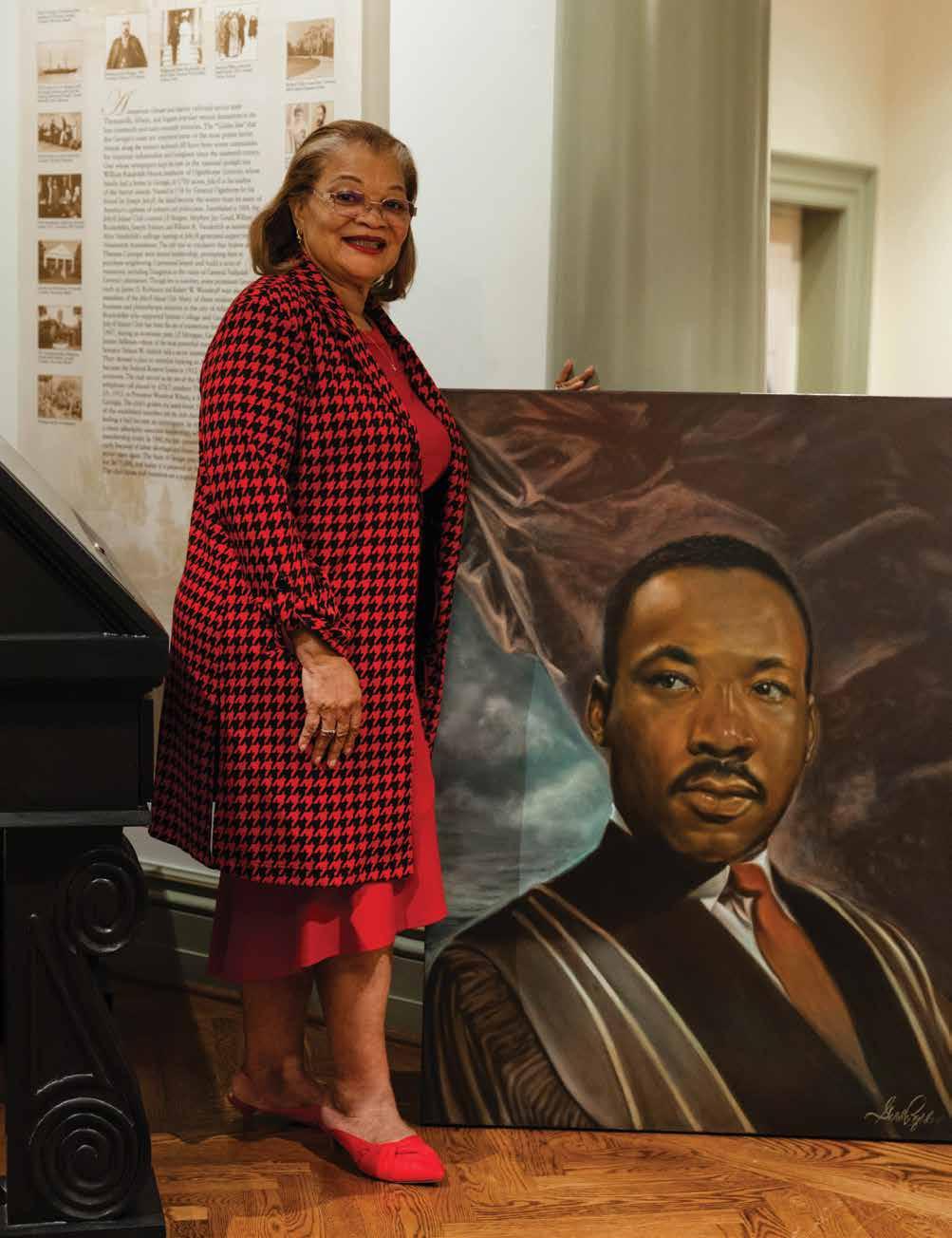
49 minute read
Alveda King
Interview Date: June 14, 2021
Alveda
DR. ALVEDA CELESTE KING is never alone. She is the niece of civil rights leader Martin Luther King Jr. and daughter of civil rights activist A. D. King and his wife, Naomi Barber King. Within her lies an unbreakable link to her family’s presence and a direct line to God’s love. These deep connections provided Alveda the unwavering strength to live a life of purpose as an activist, author, minister and even a former state representative. This is not to say that she is impervious to challenges of her faith, and as did M.L.K., she has learned to always respond with kindness. Beyond her work as a minister, civil rights and pro-life activist, Alveda is also a best-selling author, accomplished singer-songwriter, consultant to the Africa Humanitarian Fellowship, and has served on the boards and committees of numerous organizations, including the Silent No More Awareness Campaign, Coalition Of African American Pastors, and the Judeo-Christian Coalition For Constitutional Restoration. Throughout it all, she shares her message of faith, love and kindness while carrying forth the remarkable legacy that came before her. 149• l’automne 2021 • readelysian.com
Evangelist King, welcome. You are an artist, an author, broadcast commentator, songwriter, as well as a religious, political and civil rights leader— niece to Reverend Dr. Martin Luther King Jr. You are considered a thought leader in all of these areas, which is a lot of ground to cover.
I want to start at the beginning. You are the first-born child?
I am the eldest of five children, and I was born in 1951 on January 22nd.
At the time your home was bombed in Birmingham, were you in the home?
We called Birmingham “Bombingham.” I was a young girl at the time, a preteen. It was in 1963, the night before Mother’s Day, and we were in the church parsonage. My dad was a pastor. My mother had just set the dining room table with all of her china. It was incredibly beautiful. Everything fine was displayed because we were going to have a lovely Mother’s Day dinner. She walked to the picture window in the front of the house, and it began to crack. Daddy was in the back of the house because his study was in the master suite. He was writing a sermon. He noticed that the house was too quiet. The street was too quiet. He walked to the front of the house and saw my mother standing in front of the cracked window. He yelled, “We have got to get out of here.” He took her by the hand. By the time I saw them though, she was in his arms. They ran down the hall. The first bomb cracked the window. It was supposed to draw everybody to the front of the house. Then the second bomb went off. They got halfway into the house, and the front half of our home was destroyed. All of the children were in bed except my brother, Al, who was on the couch watching a war movie. So, can you see that? It was so surreal. While bombs were going off on the TV, a real bomb exploded in our home.
A metaphor for?
War and peace. And they do, co-exist. It was a tale of two cities, of course. So here we wanted the peace of God, and we were living in the anarchies of humans. There was something fascinating about that night. I still remember vividly, and talk about it now. While we got out safely, people were angry about what happened to our home and violence erupted. People began rioting, wanting to turn over cars and throw things. I remember my dad standing on the hood of a car, but I don’t remember if he had a megaphone or not. He said, “Stop. Don’t fight. If you have to hit somebody, hit me. I would rather you go home. My children and I are okay, go home.” My daddy stood on that car, calming the riot. He actually did that in the face of what had happened.
What differentiated your uncle from everyone else?
Reverend Martin Luther King Jr., we have to remember, was a preacher. He believed so much in the love of God. The love of Jesus. I believe he was a modern-day John, the Revelator, because the apostle John went to Patmos Island and wrote the Book of Revelation. He constantly talked about love. My daddy talked about the miracles of Christ, and granddaddy spoke about taking care of the least of these. But Reverend Martin Luther King, Jr. spoke about the love of God. It has been recorded that there was only one time that people remembered him stepping out of that position. It happened to also have been the day that he died when he had an argument with someone. Typically, he answered everything with the love of God.
Can you help me understand what distinguishes that type of greatness?
I have a favorite story about my uncle (ML), my daddy (Reverend AD King—AD), and granddaddy (Reverend Dr. Martin Luther King, Senior—Sr.).
AD and Senior both were feisty, but they all loved the Lord and could preach. Martin Luther King Jr. was honestly different. They traveled around the country, preaching together. One time, Daddy and Uncle ML were traveling together. Daddy was driving and ML was in the passenger seat. They passed a car whose bright lights were on and were blinding the oncoming traffic. The person was supposed to dim the bright lights, and they did not. So, my daddy said, “Brother, I am going to shine our lights back in their face.” ML responded, “Brother, I don’t believe that’s the way we should respond. We should do to them what we want them to do to us. And that has been written.” That particular story explains the two of them together and their relationship. Daddy was the champion, the guardian, and the protector of his brother. ML was more focused on the ideas of we have to love, and we have to forgive. They all believed in loving. I do too, but ML was always like that, always.
WHAT DISTINGUISHES THAT TYPE OF GREATNESS?Q. ELYSIAN Publisher, Karen Floyd, with Alveda at the Millennium Gate Museum, Atlanta, during the Inspiring Woman interview. The Millennium Gate Museum is a triumphal arch in Atlantic Station which houses Georgia’s and Atlanta’s history with historical artifacts, family heirlooms, exacting replicas and sophisticated interactive video technology that together serve as a cultural and education bridge to the future. PHOTOGRAPH BY TANYA PTITSYN

AD AND SENIOR BOTH WERE FEISTY, BUT THEY ALL LOVED THE LORD AND COULD PREACH. MARTIN LUTHER KING JR. WAS HONESTLY DIFFERENT . . . ONE a. TIME, DADDY AND UNCLE ML WERE TRAVELING TOGETHER. DADDY WAS DRIVING AND ML WAS IN THE PASSENGER SEAT. THEY PASSED A CAR WHOSE BRIGHT LIGHTS WERE ON AND WERE BLINDING THE ONCOMING TRAFFIC . . . SO, MY DADDY SAID, “BROTHER, I AM GOING TO SHINE OUR LIGHTS BACK IN THEIR FACE.” ML RESPONDED, “BROTHER, I DON’T BELIEVE THAT’S THE WAY WE SHOULD RESPOND. WE SHOULD DO TO THEM WHAT WE WANT THEM TO DO TO US . . . WE HAVE TO FORGIVE. THEY ALL BELIEVED IN LOVING. I DO TOO, BUT ML WAS ALWAYS LIKE THAT, ALWAYS.

Alveda on the arm of her first husband, Mr. Jerry Ray Ellis, as he escorts her down the aisle in July 1969. Right: Dr. Martin Luther King, Jr., center, and his brother, Reverend A. D. King, left, leading 2,000 marchers, including hundreds of clergymen, on March 9, 1965, at the Edmund Pettus Bridge in Selma, Alabama. Opposite top: Young Alveda with her father, the late Baptist minister and Civil Rights activist, Reverend Alfred Daniel “A.D.” King.
You are the only person that I know that actually knew Reverend Martin Luther king Jr. Can you fill in the blank? What made him exceptional was_____?
Martin Luther King Jr. lived what he preached. When he was challenged, he would take a deep breath and then he “fixed” himself and did what he taught others to do. He centered himself, constantly. I was able to grow up around him. I could see him do that. I enjoyed his sermons. Sometimes you needed a dictionary to understand some of his words because he was very educated; his speech was so refined. There was one speech in particular, it may have been a sermon, called the “Death of Evil by the Seashore.” It was about Jesus and the disciples. Jesus ministered to them as he went out in the boat and spoke to the storm. It represented what man has to grapple with and how Jesus taught us to respond. The love of God was what made him different. Reverend Martin Luther King Jr. was able to live it, walk it and teach it. I am a product of those teachings. Not only from him, but from his dad, who was tough, but tenderhearted. It is recorded and written that when his children were born, my granddaddy was there in the room with his wife. He cried with her as she gave birth. That was Daddy King. My mother would say to my dad that he was just like his daddy, and I was just like him. “He’ll give you his last dime,” she would say, “and you are going to give away everything.” I said, “Well, mom, I have got to give some more.” That was my dad’s philosophy and how we all grew up. I honestly saw the Reverend Martin Luther King, Jr. over and over, respond in love. He really did.
Was that a gift from God or was that willful discipline?
It is a combination of living a life of service and having willful discipline and doing what God says. The Bible says we all have a measure of faith. I believe there is a measure of love that comes to each of us, but it takes discipline as well. As I explain, I saw Reverend

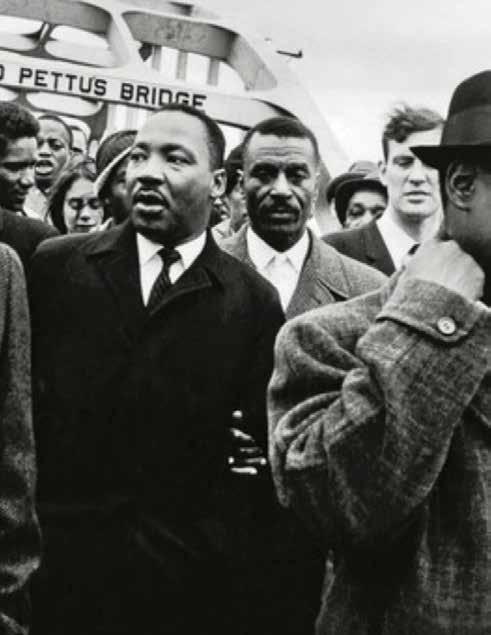
Martin Luther King Jr. practice that discipline with the God-given gift to be able to love others. There is a scripture, “Ye are of God, little children, and have overcome them: because greater is he that is in you, than he that is in the world.” So obviously Christ was in the Reverend Martin Luther King Jr., but what was Martin Luther Jr. going to do with Christ? And what was Christ going to do with him?
Do you believe that every person has a gift, and that gift has to be honed in order to be excellent at something?
There’s a wonderful scripture, “Stir up the gift of God that is inside of you.” I ask that question all the time. People even ask me, “What is your gift?” I respond, “I try to put it all together and serve God because I can’t pick. Is it writing songs? Is it singing? Is it acting? Is it politics? Is it being pro-life? I can’t pick any one gift.” I like to believe there is something within me that will take what is needed at the moment from the Lord and use it for his will. So, do I think that every person has a gift? I sure do. Maybe we have more than one gift, and we need to learn to let that real gift be accepting the will of God in our lives and acting accordingly.
Do you hear God audibly, the voice of God? Or is it more a sensation or feeling?
If I may tell you about an experience that I had when I was a young woman in my twenties. I was not a born-again Christian. That happened in 1983. This was in the seventies. I had just left the nightclub, and I was driving along alone in my car. I had been drinking and should not have been driving. Ironically, when I left the nightclub, they had offered me assistance because they knew I was impaired, but I had told the people at the club that my car was like a horse and knew how to make its way home. I drove into a storm with lightning and thunder all around me. I turned onto my street – almost to my house. There was a big clap of lightning and thunder. Boom. An electrical, live wire fell across my car, and I could see the sparks. Back then cars had a lot of metal. I really heard a voice, honest to goodness. It was so startling because there was nobody in the car with me. The voice said, “Stay. Be still and know that I am God.” I sat, my foot was on the brake, not the gas. I sat there for a long, long time, long enough to become sober. The emergency responders came and moved the wire off the car. “Ma’am are you all, right?” “Yes. I’m okay,” I said. “If you had touched anything on this car, you’d be dead. You’d be fried,” they responded. That was the only time I have heard an audible voice, and I really heard it. People have said because you were just drunk, you imagined it. No, I heard it. However, I constantly experience the presence of the Lord. When I am in a jam or when it is time to praise the Lord, I will become aware of certain scriptures. I will be aware that some will say, “No, you don’t need to do that.” Whether you turn to the right or to the left, I will hear a voice and it will say, “Walk with it.” I just hear various scriptures in my mind.
God talks you through?
The word of God, through scripture, talks to me.
Is your life predestined?
I believe that from the beginning of time, God knew, knows, and will know everything. I believe I am God’s plan. I don’t think about predestination a lot because I really don’t necessarily understand it. I also don’t believe that we are reincarnated, but even if I were reincarnated, I believe that this moment is the only moment that counts.
Do you feel the presence of your father?
I dream about my father, my grandfather, my Pastor, Alan McNair, who founded Believers Bible Christian Church. I dream about them. Occasionally, I dream about my grandmother and different people who have crossed over. I am very aware. I keep so many pictures of my family, those who are here and those who are gone, that sometimes I feel as though they are still here. I really do. I don’t talk to my dad or my granddaddy or Pastor. I actually talk to God, but I’m aware that those who have gone on before me are in a crowd of heavenly witnesses. I’m very aware that they are there.
Your father, Pastor AD King, passed away in a questionable drowning. Do you feel his presence?
Often, I do feel dad’s presence. I have his DNA, so I would feel his presence wouldn’t I? And my mom too. She is still here. So absolutely, I am very aware of my daddy all the time. I wrote a song named Is That You? Walk on Water. It is about my daddy who rescued me out of the ocean. I was a young girl, and we were at a retreat with the church. I thought I could swim because daddy could swim. In reality, I could doggie paddle, but I couldn’t swim. So, I jumped out into the waves while my Daddy was on the shore. A wave picked me up, and I screamed “Daddy.” He cut through the waves and picked me up. I said, “Where is Jesus? You said he could walk on water.” I have always been very aware of his presence. I think about my dad all the time.
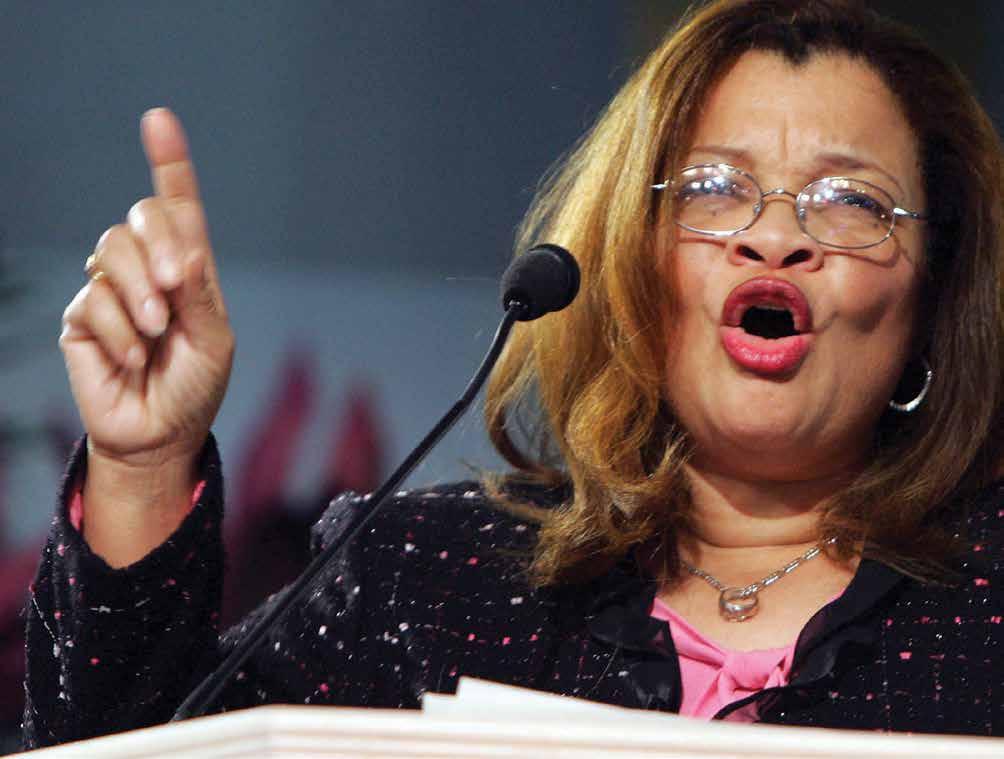
Your mother was described as a remarkably strong woman. I read that your mother contemplated abortion on your conception, and your grandfather talked her out of it. Tell me about that.
My mom and dad were high school sweethearts, and they were going to marry when they finished college. Her mother let her go on a date with my daddy, which is why I say that people who are not married should avoid dates because when you have physical intimacy, babies can come. So, they were engaged, her mother let her go out, and I was conceived. My mother didn’t want to birth a baby at that time. They were not married, but they were engaged. She was going to go to this place she learned about in a flyer that was being passed out in the schools, in the Negro community, by the Birth Control League. They were changing their name to Planned Parenthood and could not advertise abortion. It was illegal, but they had a procedure for “undisclosed female ailments,” and you could come and see them and have this procedure, and then talk. In other words, you could come and get a DNC, not a back-alley coat hanger.
You could come and get a DNC. So, my mother took that flyer to her mother. Her mother, big Mama Bessie said, “No, this doesn’t look right. Let’s go talk to our Pastor, Martin Luther King, Senior (who was going to be momma’s father-in-law). He said, “Nanny. (that was her nickname). They are lying to you. That is not a lump of flesh. That is my granddaughter. I saw her in a dream three years ago. She has bright skin and bright red hair, and she is going to bless many people.” I was born looking exactly like that. Mom and dad were married by then. They had five children, and I was the first. Later in my life, before I was born again, I had two secret abortions, and I miscarried because of a botched abortion. All that has happened to me, but from birth or before birth, I was going to be a voice for life, with a testimony that I was rescued from abortion.
When and why did you decide that you were going to follow a different path in life?
I was born into a Christian family, and I went to church all the time. When I was five years old, I was water baptized. I sang in the choir, went to Bible study and attended Christian activities for many, many years until 1983. I guess I thought I was a Christian. I did believe that Jesus was born of the Virgin Mary, died on the cross and rose again. But it never occurred to me that he died on the cross for my sins and rose again and is in heaven and is my high priest until 1983. I had been a state legislator and made multiple appearances in movies and films, then I went to work at a college for the next 19 years. There was a woman who worked at that college who changed my life. She had a big red binder and inside it there was a book that had a sword on it. I didn’t know what the book was and then one day, she opened it.
People said, “Don’t talk to her. She’s a religious fanatic.” At that time, I was the kind of person, if you told me not to do something, that’s the first thing I was going to do. So, I walked up to her and asked her, “Why do people say don’t talk to you?” She didn’t answer that question. She said, “Alveda, who is Jesus?” I said, he rose again. I remember one of the songs
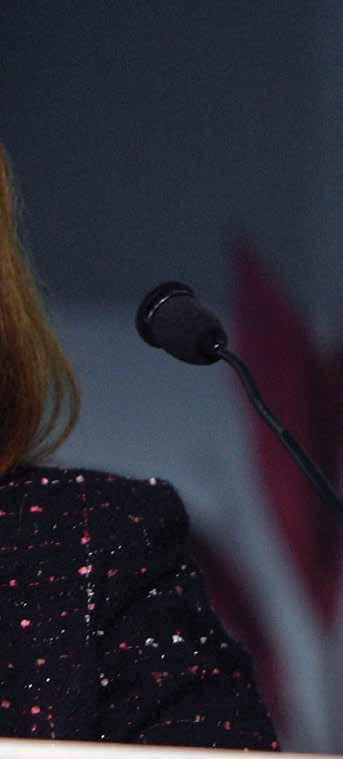
Dr. Alveda King, founder of King for America, Inc., gestures at the Justice Sunday III rally on January 8, 2006 in Philadelphia, Pennsylvania. Sponsored by the Family Research Council, the rally was held one day before the start of confirmation hearings for Supreme Court nominee Samuel Alito.
PHOTOGRAPH BY JEFF FUSCO/GETTY IMAGES
I learned when I was a child. She asked me again, “Alveda, who is Jesus?” And I began to say what I had learned in Sunday school about Jesus. Not good enough. She asked me a third time. I got angry. I remember putting my hand on my hip and looking at her. “Well, I guess he’s God.” And then I said, “No, I know he’s God.” Every question I asked her, she would open that book and find the answer in the Bible. I asked her about the Aborigines and if they were going to hell. “No,” she said, “because they never heard of Jesus.” I think it was in Colossians, “from the beginning of time, they would know enrollments.” And the last scripture, Romans 10:9, “Alveda, you know Jesus is God. If you believe in your heart and confess with your mouth that God raised Jesus from the dead, you’ll be saved.” She led me in that prayer, and my whole life changed. It was like a light bulb came on. And from that day on, I am focused on “Yes, God. No devil. Yes, God. No devil.” I have been doing that since 1983.
You have how many children?
I have six living children, two were aborted, and I had a miscarriage. So, six. Three were already born before 83 and three, three came after. I was like night and day for them, my older children are very worldly, current. With the younger children, I stopped cursing. I used to drink and enjoy bourbon and those kinds of things. The three younger ones are not accustomed to that lady. The three older ones were. We talk about that all the time now, and they’ll tease me. We all are very, very close as a family. My children tell me everything. They have told me about their experiences, and I would go into my room and put my fist in my mouth and just bite. One night, before the cell phones, when we still had the Captain Kirk flip phone, my daughter called and asked, “Are you praying for me?” I said, “Actually I am. I woke up on the side of the bed and prayed.” She asked me if I would stop because she was not able to have any fun. Three of my children are attorneys. One is in medical school. One just got her master’s from Harvard. The youngest one has not finished college. He has a full scholarship to a Bible school, but he is married and doing other things right now. They have all done well. But the main thing about it is that they all love the Lord. All six children love the Lord.
You have “stood against the wind” on many issues. Advocating a pro-life stance to supporting President Trump, how do you persevere against the shame and the humiliation people cast toward you? Where do you get your strength?
For 17 years before I was a born-again Christian, and afterwards, I have been very, very aware that God is real, and God is present. I believe that we can all find that place in the Lord, but we have to want that place in the Lord. What helps me to stand against adversity? Going on 40 years’ experience now and as the Bible Christian Church teaches, getting to know God through the Bible. I never feel alone because I can go to a secret place in God through Psalm 91. Whether I’m in a crowd, in a storm, it doesn’t matter. I can say in the face of adversity, “I know my Redeemer lives.”
Recently, one of my children asked me to ask their father to forgive me. My first thought was, he needs to ask me to forgive him. Then, I got quiet because it was a sincere request. I stayed up all night Googling, literally, how you forgive somebody who you feel did something to you. I couldn’t find a really good answer. I wanted to write an article on it, but I got so sleepy and tired. Then I said, “Holy Spirit, how do you do this?” And the Holy Spirit chuckled, not audibly, but I felt the chuckle. “I wondered if you’d ask me.” The answer was, “you could have been kinder.” So, I wrote a letter. I said, “I want to apologize to you. Please forgive me. I could have been kinder.” I did publish that in a blog. Many people responded to the post saying, “Yes, I could have been kinder.” It is something we can all do. I hide in the secret place of the Lord, Psalm 91. And I seek kindness.
That is a gift.
It is. It really is. Praise God, praise God, praise God. What could I have done Lord, that was different? You could have been kinder.
Even when you’ve been terribly wronged, you still show a little bit of grace?
It’s scary, but you can actually do it.
How do you insulate yourself from people that are not kind, in politics?
As a state legislator in Georgia in the 1970s, I was a Democrat in the House of Representatives. Across the aisle were the Republicans. Everybody was divided, but I had friends on both sides, and we wrote bills together. People asked me, “How can you do that?” I said, “I see people, and we can agree on certain things. In the political realm, I started doing that. I moved on from being a Democrat, to an Independent, to a Republican, back to an Independent. Then I became a Frederick Douglass Republican. I work across the aisles. I always have. I still do. I think that’s very important. I also see people. I am not colorblind either. Your hair is beautiful. I see your golden rings, your lovely hair. What color is your face? I can see your skin. It’s a beautiful color. Hold your hand up. You do see it. You see my skin. Do you actually see my skin? You see it. You feel the warmth in my hand. I feel it in yours. We see the color of our skin. To say, “I am color blind is not true.” Jesus gives sight to the blind. However, I recognize that it is your ethnicity, not your race. We are the human race. Turn your arm over, see the little veins that look a little blue. We are not blind. We can see color, but we do not judge each other by color. We see each other as one blood and one human race. In me, you should be able to see Africa, Ireland and Native America.
Tell me about the book you co-authored, We’re Not Colorblind.
We’re Not Colorblind is a book that I wrote with my good friend, Ginger Howard, a Caucasian lady and a Southern Belle. We met while working together politically, attending the same event. One day, we were both on a platform at the Martin Luther King Center in Atlanta, Georgia. We were the only conservatives on the panel and were being hit really, really, really
BE A BUSH IF YOU CAN’T BE A TREE. IF YOU CAN’T BE A HIGHWAY, JUST BE A TRAIL. IF YOU CAN’T BE A SUN, BE A STAR. FOR IT ISN’T BY SIZE THAT YOU WIN OR FAIL. BE THE BEST OF WHATEVER YOU ARE.”
hard. I remember scrunching down at my seat, taking deep breaths and God helping me. After the event, Ginger went home. Not long after, I had a dream that we were supposed to write a book together. In the book, We’re Not Colorblind, we talk to each other openly about our different perspectives. In the end, we are one blood in one human race. We said, open your eyes, and you will see.
One of your qualities is that you are not judgmental. You judge no one?
Not at all.
Where does that come from?
God has forgiven me so much I can’t afford to judge anybody else. I’m still working out my own salvation in fear and trembling. I just don’t. I see all human beings in need of a savior. All of us…Buddhist or Hindu or Muslim or Jewish or Christian. We are all human beings. John 3:16 doesn’t say, “God, so loved the Jews, the Christians, the Mormons, the Muslims…” The Bible says, “For God so loved the world...” We are the world. Every time I want to judge somebody, God reminds me of what I used to be. And he says, you used to be like that.
What vocation brings you the most joy?
My most rewarding vocation is being an evangelist, a Christian evangelist, after that a pro-life advocate.
Can you remediate decisions that are not—in your opinion—in alignment with the Bible?
I don’t know that I can remediate my poor decisions, but God can do anything. Everything that we do can be under the blood of Jesus. I still live that way today. Recently, I did something. I was under pressure and under stress, and I said something that shocked everybody. It could have been something I should not have said. I went and got quiet. Before I even took another step past what I had said, the Holy Spirit began to talk to me and reorganize and restructure. Christ, of course, is our remediation—remains our remediation on the blood of Jesus. I understand that. But then Paul says, so should we just run around and sin because we know that we’re going to be forgiven? No, absolutely not. We still have to work very, very hard.
You are a truth seeker and an outspoken advocate for the pro-life movement. How do you know that your truth is more profound than a pro-choice truth?
When I see a 4D ultrasound, 3D, or even the initial ultrasounds. When I saw the last baby I was about to abort, and I saw this little black and white picture of that heart, I knew it was the truth because I can see. I know that you and I are sisters, regardless of your skin color, which I can see, but we’re sisters. So, I, when I say truth, I know truth, and the goal is not only to know, to seek truth and find it, but then to share it, truth or love, both equal. I am the way the truth and the life. God is love. I mean, that is God.
How do you listen to the voice of God, and do you ever not listen?
Rarely do I not listen. I have learned that when I don’t listen, it does not work for me. I have a deck on my home, and I walk out on it and get quiet and hear the birds. When the weather’s right, I can hear the rippling water in the little pond outside. I just stand there and listen. There are very few people who I allow in my home now, and most people close to me know I do not open my house because God lives there. My children and grandchildren know that.
What is your legacy and your life all about?
I believe, as human beings, when we understand that we belong in the heart of God, we are humanity. There is a word that you just mentioned, “legacy.” Most people do not understand. Legacy is so clear in the Bible. This family was gifted to do this. This family was gifted to do that. This group could do one thing. That group could do something else. It is very clear in America that we have lost a sense of legacy. Over our 400 plus years, we stopped remembering our origins, though some ethnic communities know more than others. The Black community really lost legacy because we could not know who our parents and grandparents were. I am blessed because I know our origins are in Africa, Ireland and Native America. But we are an unusual family. Legacy as human beings and connecting with natural families is important. But the lasting legacy of belonging to God should be the goal of every human being.
What is your focus every day?
Every day I remember that God so loved the world that he gave us Jesus and whoever believes in Jesus will not perish. That’s a burning truth in my heart and in my life. I am very conscious of that particular part of my life and my mission every day.
When I ask you questions, you always go to a Bible verse. Pre-1983, give yourself one piece of advice. Just one.
Stop girl. Trust the Lord with all your heart. Don’t lean into your own understanding. It is going to get you in trouble. That’s exactly what I’d say to younger me, easily.
And what piece of advice would you give to any other woman?
God loves you. God loves you because everybody needs love. We all seek love. I do that all the time. I just say, God loves you.
You believe this?
I really believe it with all my heart. People will be lost, but that is not what God wants.
Is there an Evangelist King message to share?
Each person living has a purpose. Don’t abort your purpose. Keep faith, keep hope and keep love. Don’t give up, keep moving forward. That was fabulous, Karen. Thank you. Thank you. Thank you so much.
I saw your tears a couple of times which is how I know when people hear the message.
Thank you, the enlightened Evangelist King. ■
SPEECH BEFORE A GROUP OF STUDENTS AT BARRATT JUNIOR HIGH SCHOOL IN PHILADELPHIA, OCTOBER 26, 1967
—DR. MARTIN LUTHER KING JR.
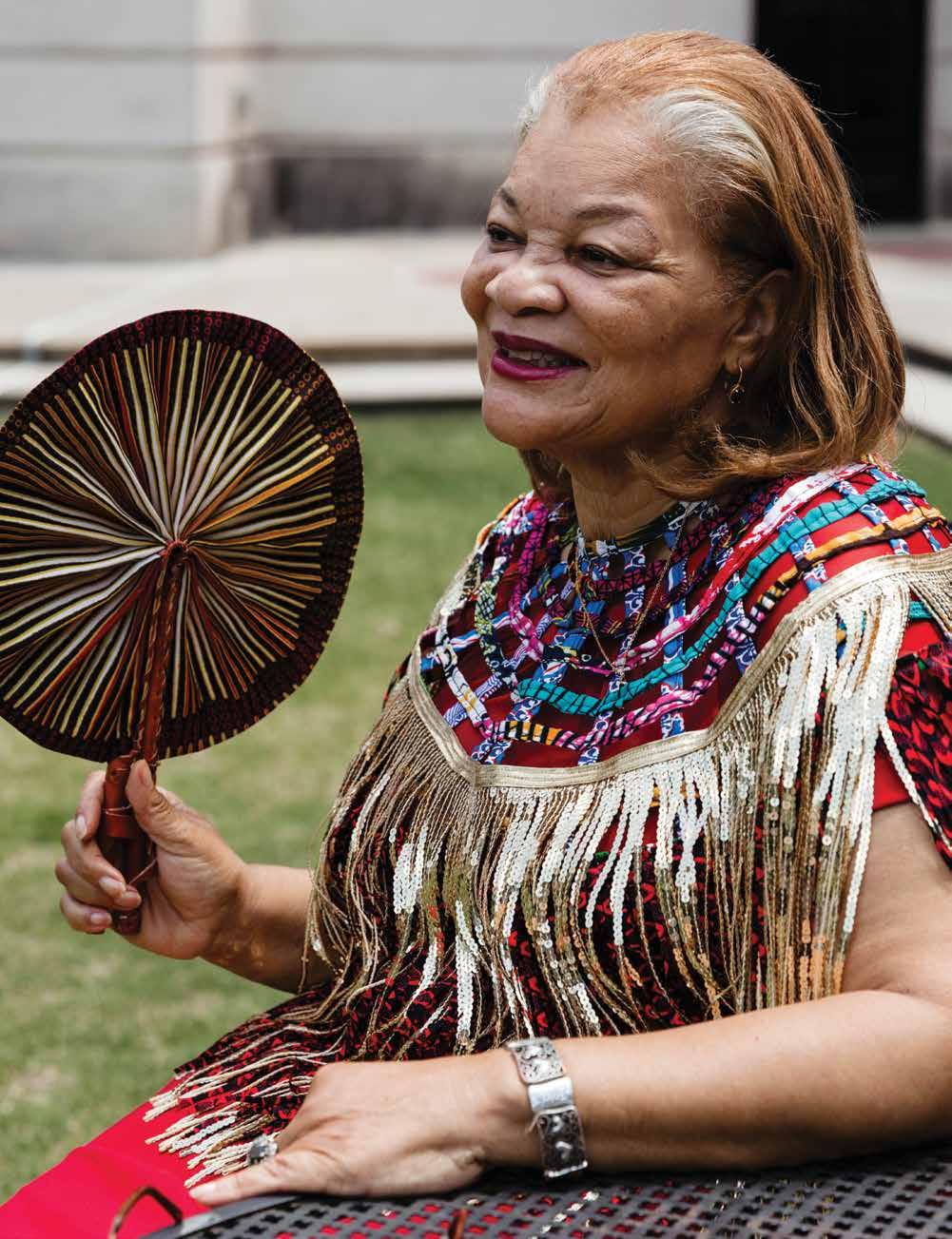

Badrutt’s Palace Hotel, Via Serlas 27, 7500 St. Moritz, Switzerland, +41 81 837 1000
For more information or reservations, +41 81 837 1000, Fax +41 81 837 2998
reservations@badruttspalace.com
change creator
Amina Khalil:

Egyptian-American actress Amina Khalil, photographed at the El Gouna Casa Cook Hotel in Egypt, opens up about her work and reaching her fans outside of the Arab world.
PHOTOGRAPH BY AHMED ZAATAR / MAKEUP BY PERRY SABER
BEing thE BEstVErsion of hErsElf
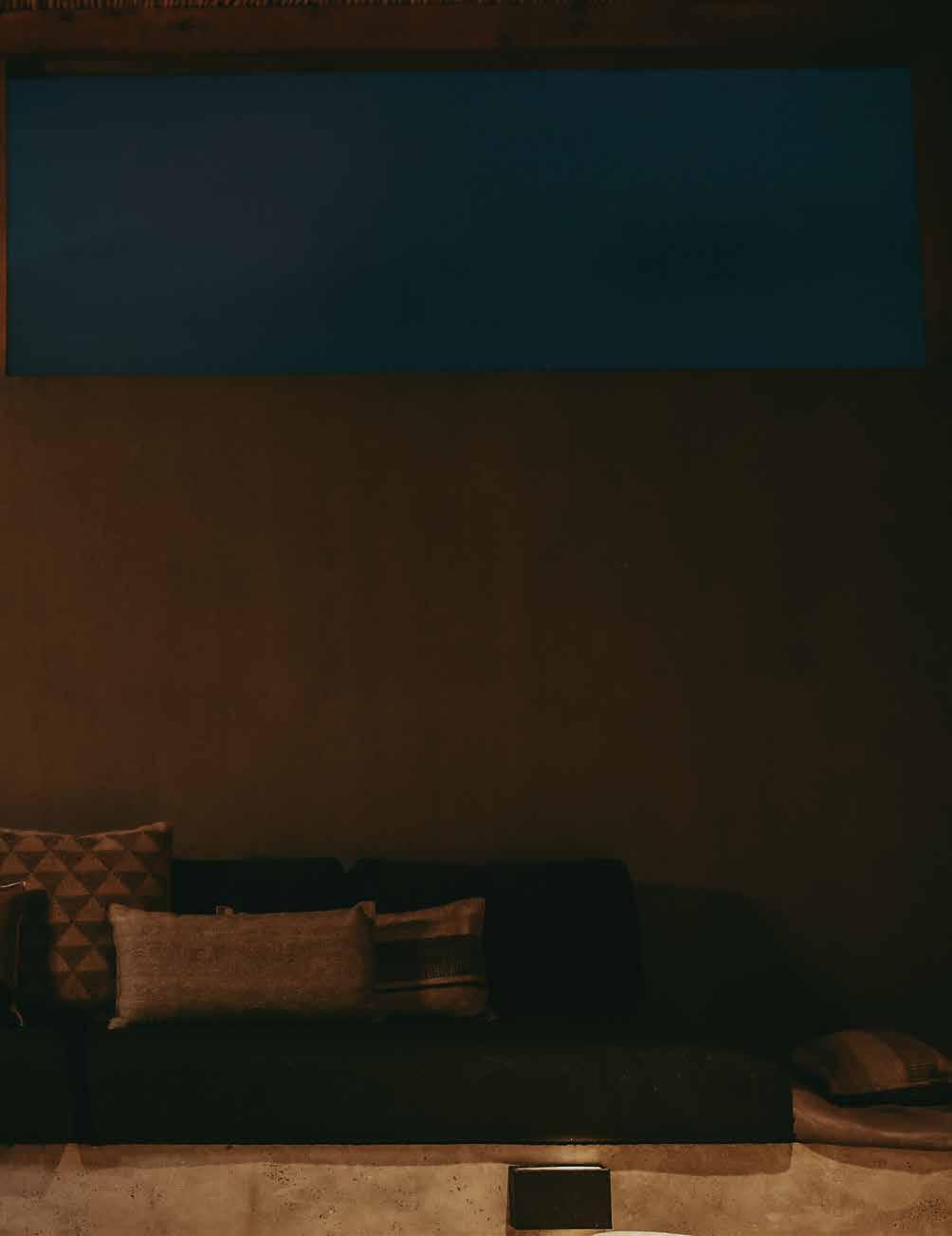
BY ALLYSON PORTEE
readelysian.com • l’automne 2021 •161
Amina poses for a photo at the Casa Cook Hotel in El Gouna, Egypt where she talks about her lifelong dream to be an actress, but her aspirations to also be a mom and to take things slow in her career.
PHOTOGRAPH BY AHMED ZAATAR / MAKEUP BY PERRY SABER
inding a gratifying career can feel (almost) too good to be true. With a busy life in the acting industry under her belt, Amina Khalil is taking it all in, reaching a point in her career where she can choose which projects she takes on—and she’s looking onwards from Covid-19 with hope in a world that desperately needs it. She’s outgoing and lively and has acted in numerous Egyptian films and TV shows for more than a decade. Amina Khalil has dreamt of being an actress from the age of three. Her sense of destiny of wanting to connect with people through stage and film has led Amina to a pretty successful acting career. She has played thought-provoking roles that touch on the issues Arab women face in Egypt and in the region, roles which make her Arab female fans connect with her all the more. And while she’s reaching a level where she can choose her roles, there’s no sign of Khalil stopping what she loves most. Born in Chicago, the 32-year-old actress f credits being American to the way she views life. “I feel that I was very lucky and blessed to be exposed to Western culture growing up. It definitely shaped a lot of who I am today in terms of my thinking, and being open-minded,” she shares. “I had access to a different culture growing up so it did affect me.” Her uncle is renowned Egyptian jazz musician Yehya Khalil, known as the founding father of Oriental Jazz, and she studied in the US like him, getting first her bachelors in Egypt at the American University of Cairo, she then went on to train at the
Lee Strasberg Theater and Film Institute in New York City, and from there she received training at the Moscow Art Theater in Russia. Khalil joins many film greats, like Marilyn Monroe and Sally Field, who studied at the Lee Strasberg Theater and Film Institute. “I went to Strasberg when I was 22. I was fresh out of university and eager to learn. As much as I benefitted from Strasberg, what’s more important is the experience of being in NYC, being an Arab woman.” Raised in Cairo, Khalil spent a lot of time in the US as a child but lived in New York City in her twenties, alone. For those who know Arab culture, young Arab women don’t live alone, even after university. They go from their parents’ house to their marriage house. But Khalil came from a family that allowed her to live abroad and alone, and she loved it. Her time in New York studying and working as a waitress, with no family close by, taught her independence. From learning how to balance a checkbook on her own to living with a roommate and learning boundaries, Khalil’s early adulthood prepared her for the world. A lthough she is American, Khalil feels herself to be more Egyptian. “I can’t say I feel American because I’ve lived 33 years in Egypt, so this is my home. I feel more Egyptian than I do American, but I also feel very much at home when I’m in the States, so I have a very healthy balance. I fit into American society when I visit the States. I have a lot family and friends there. With my family in the States, we grew up miles apart with very different cultures, and at the end of the day when we sit together it feels like there is no difference. I feel very lucky and blessed to hold dual citizenship. It makes me feel like a very well-rounded and exposed person.”
Khalil’s “ah-ha” moment when she realized her future would be in the film industry was from watching Disney movies as a child. “I loved the stories and reacted to the characters I saw from the Disney films. I would have my friends play parts and I would play a part,” she remembers. “I’ve always wanted to be an entertainer.” Her family was not surprised at her career path. “I’m the clown of the family,” she laughs. Just sitting with her, her larger-than-life personality pops out and it’s clear she loves people.
Her breakout role was in 2016 in a Ramadan series, The Grand Hotel. On Netflix it’s titled “The Secret of the Nile,” and it details in thirty episodes a man named Ali, played by actor Amr Youssef, who arrives at a luxury hotel in Aswan, Egypt to visit his sister only to find that she has disappeared. In his attempts to find her he falls in love with the hotel owner’s daughter Nazly, played by Khalil.
But it was her role in a series called Leh La’a (‘Why Not?’ in English), directed by Mariam Ab, where Khalil played a thirtyyear-old woman who wants to gain independence from her family, move out, get a job, and live on her own. It was planned that her character would marry, and though the marriage wasn’t arranged, it was a pushed union. “This was a groundbreaking experience,” she notes, “because I had a lot of women come up to me and say ‘we know exactly what your character was feeling.’” The series crossed the line drawn between parental guidance and independence and self-growth, which can get a bit blurry with Arab culture. It’s not every day that you find a character that stands up for it and voices
. . . a lot of women come up to me and say ‘we know exactly what your character was feeling.” The series crossed the line of where parental guidance is drawn with independence and self-growth, which can get a bit blurry with Arab culture.”

it, tackling an issue that is very close to a lot of women.
“Now, through social media, it’s definitely much easier to connect with friends and fans throughout the world,” Amina shares. “I do get a lot of messages from people reaching out saying things like, ‘We are from New Jersey or Canada and watch your film with our Arab friends.’ This happens a lot during Ramadan—you know, it’s 30 consecutive days long, an hour of prayer a day. During Ramadan we gather with friends and often sit and watch TV. We have breakfast together to break our fast. A lot of my Arab fanbase in the United States get together to watch the shows that I’m in. I’ve even received pictures from fans gathering with their friends in California, watching my shows together on TV. So, social media has made it easier to connect and get to know my fanbase much better.”
Khalil and her fiancé, Amr Taha, are looking forward to building a family together. “I’m never going to stop dreaming. I dreamt to be an actress. I dream to be a mom one day, so I think as long as I keep on dreaming, it gives me the incentive to reach my dreams and fulfill all of them one step at a time.”
Her twenties brought her career success, her thirties have made her more grounded. “I think my thirties have been great so far,” she muses. “I think you’re apt to be a lot more grounded. In your twenties, you still have your head in the clouds, but definitely in your thirties you know yourself a lot better, and you know what you want and where you’re going. At the same time, I am enjoying traveling this personal road of discovery and learning not to give in to anxiety. I’m a lot calmer now. I don’t have the stress of having to know who I am and be someone I’m not. I take myself seriously but not too seriously.”
When she’s not acting and has time, the actress helps her mother, an animal activist who rescues Egyptian Baladi dogs, an ancient breed of sight hounds descended from the Egyptian Saluki, which was favored by the Pharaohs. “We rescue dogs who have been abused, hurt, and abandoned, restore them to health, and find them new and loving homes.” When she can’t be there to help with the rescue, Amina covers much of the expense of caring for the dogs as they are readied for foster care.
She has new projects lined up for this fall. But with all that she has going on, she’s able to purposely rest and choose which acting projects she takes on. “I’m lucky enough to be in a position where I can be more selective with my roles and truly take on characters and stories that mean something to me. I did that last year with a Ramadan show that was a passion project. Right now, I feel I can push it up a notch and consider my next steps. It’s not about the number of films I do in a year, or even getting my name out. I think that right now I can afford to make art and tell stories that speak the language that I want to put out into the world.”
To be the best version of herself that she can be, Amina says, “We have to still remind ourselves to remember that we are here to be loved and allow ourselves to be vulnerable, and that we’re all human.” ■
philanthropy
NAWA: The Original Art Influencers
BY SUZANNE JOHNSON

HOW THE OLDEST CONTINUING WOMENS ART CLUB IS STILL CHANGING THE ART WORLD FOR WOMEN.

Joyce Werwie Perry-Lawrenceville’s pop up exhibit from November of 2018.
Edith Mitchell Prellwitz, Impressionist and Tonal American Artist of the Gilded Age, Women’s Vice President of the Students Art League of New York, and founder of The Women’s Art Club (now NAWA), photographed in her studio in New York City, circa 1890. Below: Five NAWA officials, circa 1928-1930, of the then called National Association of Women Painters and Sculptors. Opposite: Christie Devereaux De Cesare, new NAWA President, Summer 2021, and Natalia Koren Kroft, former NAWA President 2019-2021 and board member photographed in the portrait parlor of The National Arts Club.

In 1889, female artists in New York City, inspired by the rising tide of social change five and fed up with being overlooked and undervalued in the male dominated fine art world, made use of their rare education and advantage in society to improve the opportunities for all women who desired a career in the fine arts. To realize this vision, they created The Woman’s Art Club of New York, known today as the National Association of Women Artists or NAWA.
In 1890, one year after The Woman’s Art Club was formed, the League of Women Voters, as it is known today, was also formed. While the 19th Amendment giving women the right to vote would not pass until 1920 (thirty years later), the founders of The Woman’s Art Club moved forward confronting the gender-based bias that shut them out. This bias was pervasive and deep and still impacts the fine art world today. The founders, Anita C. Ashley, Adele Frances Bedell, Elizabeth S. Cheever, Grace Fitz-Randolph, and Edith Mitchill Prellwitz didn’t waste a New York minute challenging the “boy’s club” bias that adversely affected the professional training and exhibition opportunities for female artists; women were primarily barred from both until the 1870s in the United States.
“Women did crafts. Men did fine art,” Natalia Koren Kroft, former president of NAWA, 2019-2021, and current board member explained. “Female painters, like our NAWA founders, some of whom studied in Paris and trained at the Students Art League of New York (originally The National Academy of Design), were not allowed to show their work among men—men with whom they painted the same model.”
The fact that female artists were believed to be inferior to male artists should not come as a surprise to anyone—chauvinism is known to have existed outside the fine art world (eyeroll). Nor should anyone be surprised to learn that female artists were consigned or associatively discriminated to the work of crafts and decorative arts, like needlework and sewing, given the cultural norms of the time. A point of interest: women dominate the fiber and textile art world, a revered and valued category of the art world today.
But more to the point, the NAWA founders and their early members had a collective confidence in step with the suffragettes of the time, in short, “We hold these truths to be self-evident, that all men and women are created equal.” Art is subjective, but rights are not. To achieve their vision, the club created higher standards for women artists, promoted exhibit opportunities and therein pursued the respect they deserved as artists, not as female artists. The Woman’s Art Club achieved immediate success right from the beginning. Their annual exhibition attracted leading female artists like Mary Cassatt, Suzanne Valadon, Rosa Bonheur and Cecelia Beaux. Membership grew with talented artists who later achieved great recognition, including forward-thinking, prominent artists like Gertrude Vanderbilt Whitney and Anna Hyatt Huntington. Gertrude Vanderbilt Whitney established the Whitney Museum of Art in New York City and Anna Hyatt Huntington, along with her sister Harriet Randolph Mayor, created the sculpture museum, Brookgreen Gardens in South Carolina. Many NAWA members and supporters have exhibited in major museums, such as the Metropolitan Museum of Art and the Museum of Modern Art, and have taken their rightful place among the recognized artists of their time. Some of these artists include Louise Nevelson, Malvina Hoffman, Cleo Hartwig, Minna Citron, Nell Blaine, Dorothy Dehner, Alice Neel, Marisol, Pat Adams, Judy Chicago, Miriam Schapiro, Janet Fish and Audrey Flack. Being the oldest continuing women’s art organization in the United States, it is impossible to list all the members and honorary members who have defined


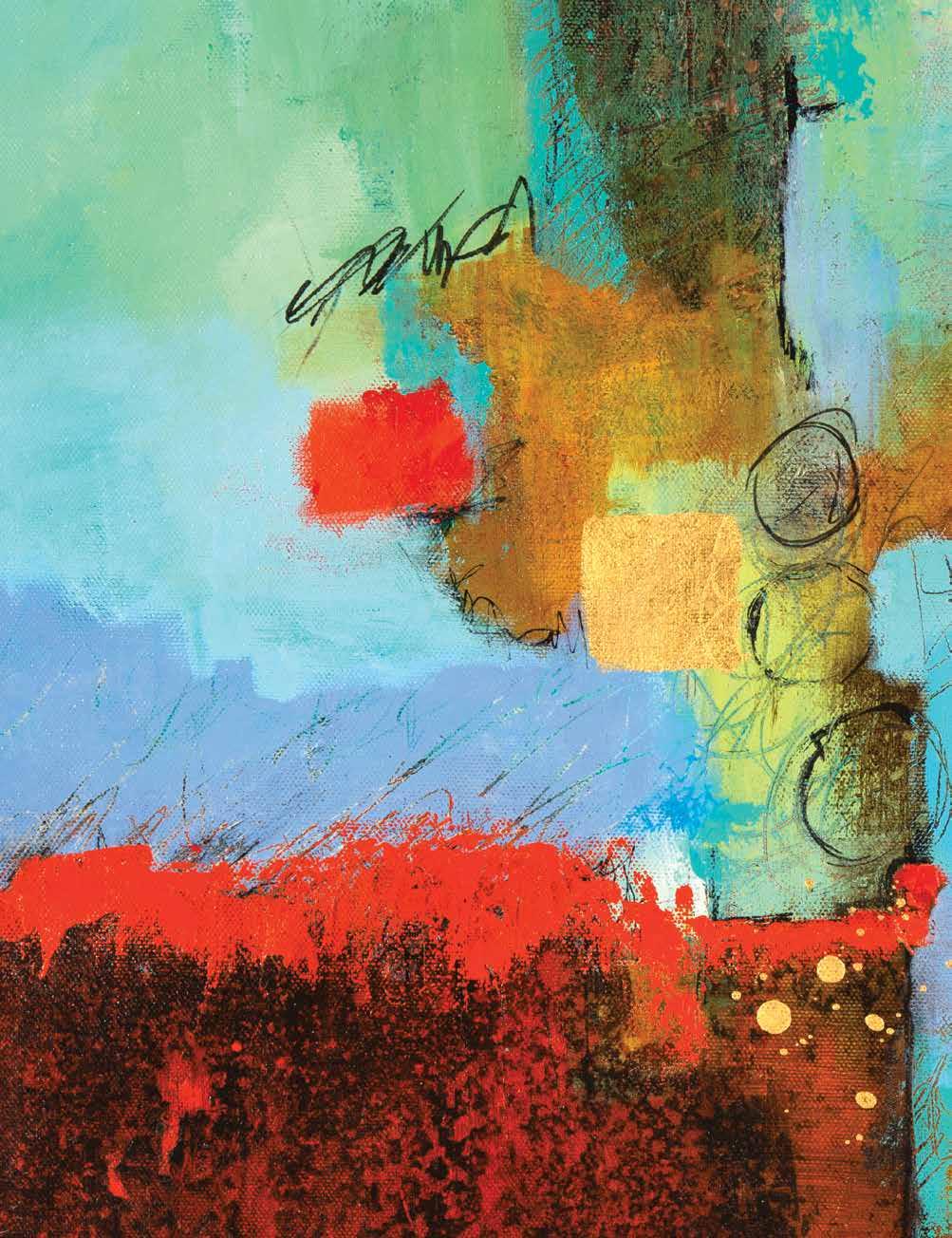

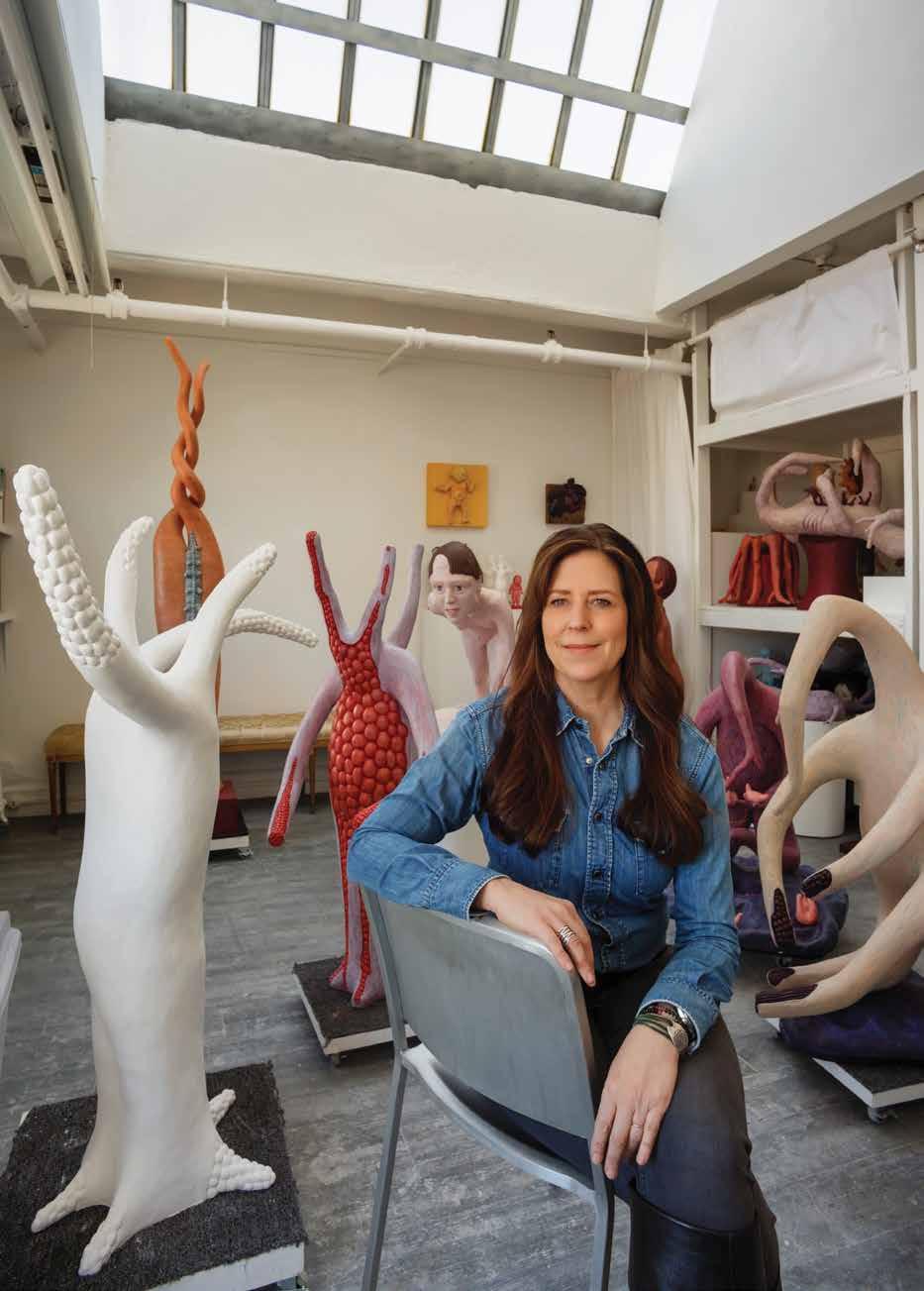

In The Beginning, collage, by Carole Kunstadt. Below: Leahbra Bag 1 by Leah K. Tomaino. Opposite Sculptor and NAWA member Judith Modrak photographed in her studio in 2018.
and continue to distinguish NAWA, then and now. All NAWA members and their work can be found in NAWA’s Annual Exhibition Catalog as well as in the NAWA historic archives which are housed at leading museums, institutions, and universities such as the Solomon R. Guggenheim Museum, the Smithsonian Institution, the Museum of Modern Art, Harvard University, the Metropolitan Museum of Art, and the Library of Congress.
It is a widely known yet catastrophic fact that countless women artists, both their names and artwork, have been lost in history, but fortunately, there was a strong movement in the 20th century that advocated for women artists, and this continues today. One great example is The NAWA Permanent Collection, established in 1991 under the leadership of Liana Moonie, president of NAWA from 1987-1989, that is housed at the Jane Voorhees Zimmerli Art Museum at Rutgers University in New Brunswick, New Jersey. The full archive is housed at the Alexander Library, also at Rutgers. The collection contains the work of artists dating from the organization’s earliest day to the present, including documents such as member cards, artist education and exhibition information, press releases, photographs of artwork and the NAWA Annual Exhibition Catalogues.
In addition to frequent viewings of their artwork, one can also find invitations and promotional materials from significant historic events such as NAWA’s participation in the Women’s Advisory Council of the 1964/65 World’s Fair, the feminist expo 2000 celebration of the new millennium, and the First International Women’s Day on March 8, 1975. The United Nations named 1975 as the “International Year of the Woman” and NAWA hosted a signature reception where prominent women spoke about the future of women in the arts; a logo with the symbol of a dove, an equal sign and the gender symbol of a woman was created to commemorate the spirit and progress of the times, (I wish I had a t-shirt of that). The collection provides a rare, historic canon of the shared and enjoyed experiences of NAWA’s past experiences that continue to be an important part of the NAWA community today.
Now in its 132nd year, NAWA remains committed to its mission “to promote awareness of, and interest in, visual art created by women in the United States.”
As a non-profit, NAWA is primarily a member run organization with officers and an executive board that exists on volunteerism and, only recently, a few paid employees. NAWA has sustained itself through generous and loyal donors, sponsors, supporters, but primarily through membership.
True to its mission, NAWA maintains a high but nondiscriminatory standard for membership acceptance and, as of 2021, accepts quarterly applications for membership juried by professional peers. Evaluated and accepted on a case-by-case basis, there are currently more than 700 NAWA members across the United States, representing all areas of the visual arts including painting, works on paper, sculpture, encaustic, collage, digital, photography, printmaking, fiber art, video art installations and mixed media.

Still based in New York City, NAWA has active chapters in Massachusetts, Florida, and South Carolina. The benefits of membership are many, including a substantial awards program, the opportunity to display artwork throughout the U.S. in the NAWA exhibitions program, inclusion in NAWA’s Annual Catalog and, as of 2020, an active social media network on Facebook, YouTube, Instagram and LinkedIn.
Tragic, difficult, and life-changing as Covid-19 was, NAWA faced the pandemic proactively, realizing how crippling the isolation would be for a non-profit, member-driven art organization reliant on personal or social engagement. Under the leadership of Natalia Koren Kroft, also a professional artist, educator and art administrator, NAWA created a virtual community for its members to stay connected, learn, exhibit, and grow, in keeping with the NAWA mission. You don’t last for 132 years without moxie and ingenuity; NAWA was founded on progressive thinking and Covid-19 required that NAWA expand into social media to stay current and evolve. And it has.
Agua XVI Ripple by Muffy Clark Gill.



NAWA’s social media manager, Emma Seely-Katz, a graduate of Parsons and self-described behind the scenes person, curates and manages all content and activity on Facebook, Instagram, and YouTube. Enabling a wide range of content postings—such as photos, video and live video for artwork, as well as feedback and messaging—has created “a community hub” that offers member art exhibitions, artist interviews, member updates, NAWA news, education and useful tips for users who primarily are NAWA members, but also non-NAWA members, or the art curious, that help build the NAWA brand, cultivate new memberships and, above all, reinvigorate member participation. Check out NAWA’s website www.thenawa.org for information about exhibitions, upcoming events, membership and student membership, the NAWA NOW newsletter and Fresh Paint, a column featuring young artists.
Instagram is NAWA’s most active platform with more than 1500 followers, impressive for a non-profit. Christine Shannon Aaron, a member of NAWA for more than 20 years and a recent Instagram “NAWA Artist of the Day,” shared her enthusiasm as a materialbased mixed-media artist, about NAWA’s pivot and expansive direction. “Instagram is a great vehicle for member exposure, public forum messaging, and driving collaboration for exhibition and other services meaningful to artists in our post Covid-19 world.”
By expanding virtually, under the direction of NAWA exhibition committee chair Joanna Biondolillo, NAWA has been able to significantly expand the number of member exhibitions and exhibition collaborations. As New York, like the rest of world, safely reopens Joanna, along with Christie Devereaux De Cesare, VicePresident Jill Baratta, Natalia Koren Kroft, other committee heads, staff and volunteers, are preparing for NAWA’s biggest exhibition of the year, the 132nd Annual Exhibition. “To the relief and excitement of everyone, the exhibit will be in brick and mortar and in person,” Christie told me with a big smile. The 132nd Annual Exhibition, like all Annual Exhibitions, includes submissions from current NAWA members and many awards are given. The show is free to the public and will take place October 16–23 at One Art Space, 23 Warren Street, in Tribeca, NYC.
Additionally, The National Association of Women Artists just opened their new office in The National Arts Club of New York. Located in the beautiful Tilden Mansion at 15 Gramercy Park South, this world-class cultural arts club also opened in 1898, and what a perfect fit it is. Both clubs opened the same year, no doubt influenced by the vibrancy of American Renaissance and, at the time, both trailblazers had a shared mission to foster and promote the arts for all. The National Arts Club was the first club in New York City to allow women members: Indeed, a perfect fit.
While there has been great progress for women in the fine arts, especially notable since the 1970s, women have never been treated equally in the art world, and today they remain dramatically underrepresented and undervalued in auction houses, galleries and especially museums. “It’s a balancing act,” Natalia Kropf and Christie Devereaux shared with me. “While NAWA is working to encourage contemporary and emerging artists, it is vital we continue to honor the long and important role that women have played in the history of American culture and art.” Natalia continued, “NAWA still exists, NAWA is still relevant, and our mission is still relevant because, as of today, 2021, the national representation of women artists in museums is still only 20 percent.”

Thefine arts industry is seeing significant and deserved recognition and gains for women artists, yet this 80/20 disparity in our national museum collections, the shocking 2 percent earnings total for “work made by women” sold at auction (2008-2019), the common practice of comparing women artists only with one another, and the winner takes all dynamic that concentrates on a disproportionate few, are but a few of the reasons why The National Association of Women Artists feel they remain an important association for female artists today. Natalia and Christie credit NAWA with having provided them an enhanced opportunity to work and grow as artists and describe the NAWA community as a sisterhood that remains a resourceful, supportive, and enjoyable part of their lives.
NAWA’s history is the story of women artists in the United States and the story is still unfolding; it is as important to look back on as it is exciting to look forward to. NAWA remains inclusive, serving all professional female visual artists of all backgrounds and traditions who are at least 18 years of age and United States citizens or permanent residents. ■

Subtle Exhuberance, Tree Peony, oil on canvas, by Mary Ahern. Above: Tedra With Flowers In Her Hair by Eddi Fleming. Opposite: Artist and NAWA member Nansi Lent in her studio.
Queen Lace Crystal offers stemware, barware, decorative accessories, corporate gifts, bridal registry and custom creations. As a mission driven business, your patronage helps us to contribute to wildlife conservation.
queenlacecrystal.com

colorfully elegant
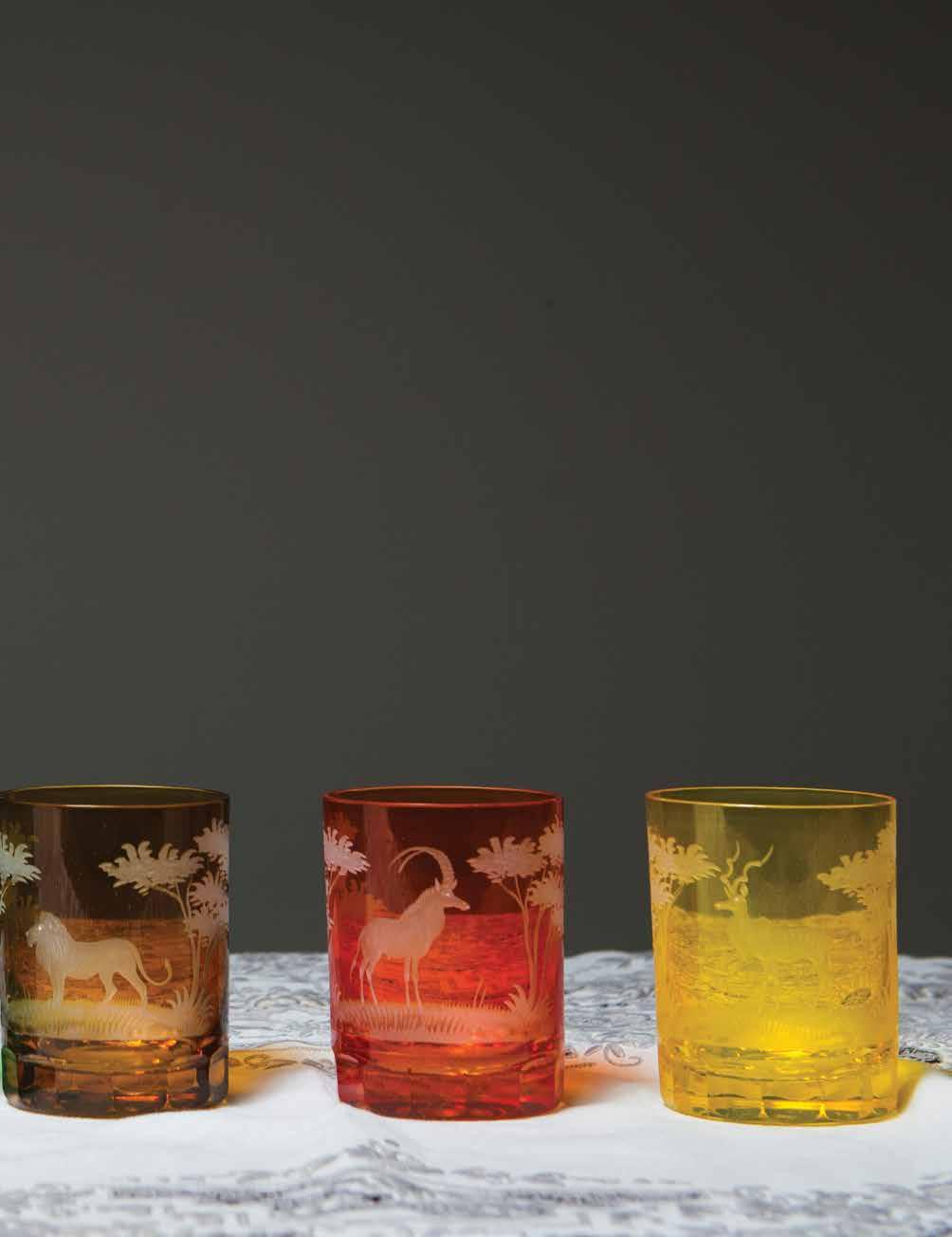
back story

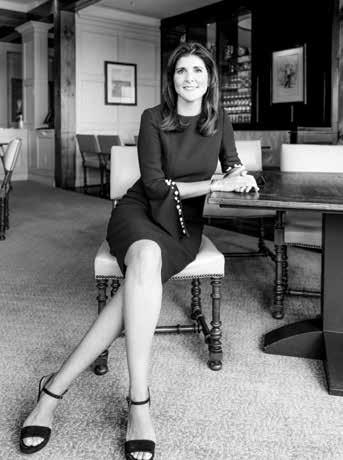
PHOTOGRAPH BY TANYA PTITSYN PHOTGRAPH BY GRACE BELL / HAIR & MAKEUP BY ASHLEY BROOK PERRYMAN
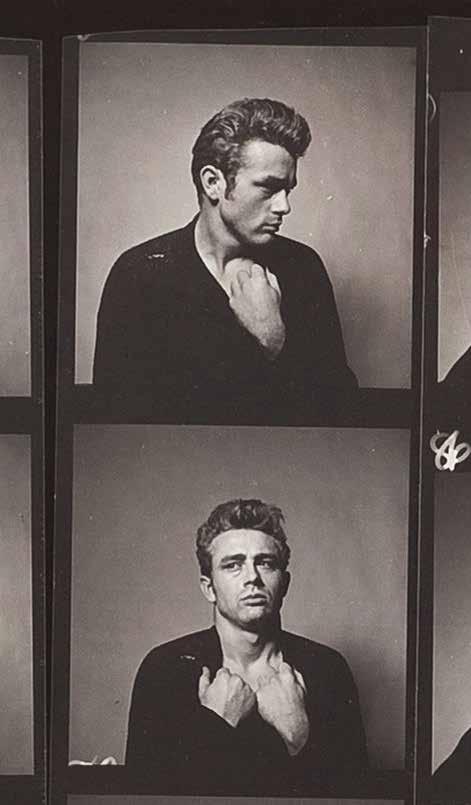
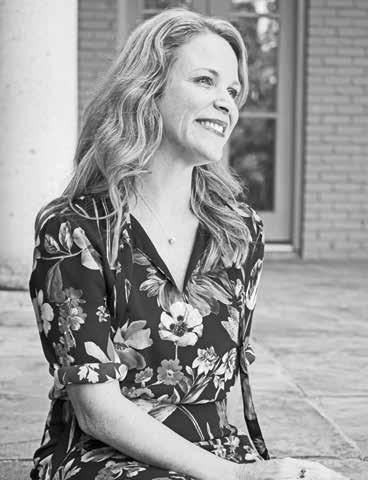
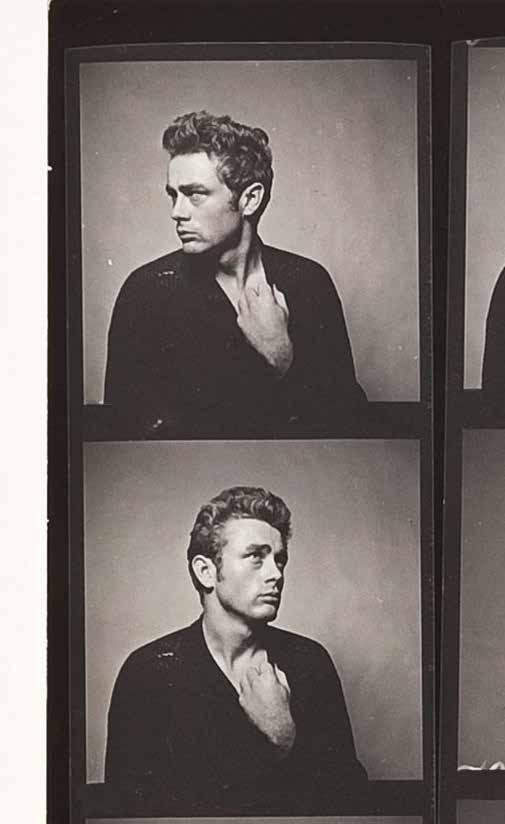
PHOTOGRAPH BY ROB SPRINGER

180 • l’automne 2021 • readelysian.com
PHOTOGRAPH BY LISA PAVLOVA
With appreciation for the “Thought Leaders” whose lives inspire women around the world—and helped inspire this issue: Alveda King (top left), Nikki Haley (top right), Kristin Harmel (bottom left) and Bea Sibblies (bottom right). ■




